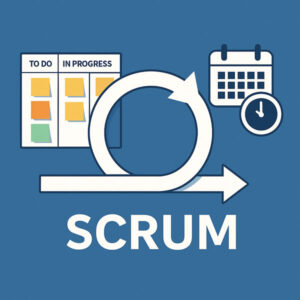 SCRUM is one of the most popular Agile frameworks used in software development—and increasingly across other industries as well. At its core, SCRUM is a lightweight, flexible, and highly iterative approach to managing complex work. It focuses on team collaboration, transparency, and rapid delivery of functional products. But despite its popularity, many teams still misunderstand its true purpose or fail to implement it effectively. This guide offers a practical overview of SCRUM: what it is, how it works, and why it matters.
SCRUM is one of the most popular Agile frameworks used in software development—and increasingly across other industries as well. At its core, SCRUM is a lightweight, flexible, and highly iterative approach to managing complex work. It focuses on team collaboration, transparency, and rapid delivery of functional products. But despite its popularity, many teams still misunderstand its true purpose or fail to implement it effectively. This guide offers a practical overview of SCRUM: what it is, how it works, and why it matters.
What Is SCRUM?
SCRUM is an Agile framework designed to help teams develop, deliver, and sustain complex products through adaptive planning, early delivery, and continuous improvement. It breaks work into time-boxed iterations called Sprints, usually lasting two to four weeks. Each Sprint delivers a potentially shippable product increment, allowing teams to continuously refine their work based on feedback and changing requirements.
SCRUM is not a process or technique. Rather, it provides a framework within which teams can apply various processes and techniques. It promotes a clear set of roles, events, and artifacts that foster collaboration and adaptability.
Key SCRUM Roles
SCRUM defines three primary roles:
- Product Owner
- Represents the customer or stakeholder.
- Defines and prioritizes the Product Backlog.
- Ensures the team is working on the highest-value features.
- SCRUM Master
- Acts as a coach and facilitator for the team.
- Helps remove impediments and enforces SCRUM practices.
- Protects the team from distractions and keeps them focused.
- Development Team
- A cross-functional, self-organizing group responsible for delivering the product increment.
- Collaborates daily and commits to shared goals during each Sprint.
Core SCRUM Events
SCRUM revolves around a predictable cycle of structured events:
- Sprint Planning: The team collaborates to decide what work will be done during the Sprint. They pull prioritized items from the Product Backlog and create a Sprint Backlog.
- Daily SCRUM (Stand-Up): A 15-minute time-boxed meeting held each day for the team to synchronize, share progress, and discuss obstacles.
- Sprint Review: Held at the end of the Sprint to demonstrate what was built and gather feedback from stakeholders. This helps shape the direction of the next Sprint.
- Sprint Retrospective: A dedicated session for the team to reflect on what went well, what didn’t, and how they can improve their process.
Key SCRUM Artifacts
- Product Backlog: A prioritized list of features, enhancements, bug fixes, and technical work needed for the product.
- Sprint Backlog: A list of tasks selected for the current Sprint, along with a plan for delivering them.
- Increment: The completed work from the Sprint that meets the team’s Definition of Done and is potentially shippable.
Why Use SCRUM?
SCRUM’s popularity is grounded in its ability to:
- Embrace change: Requirements often evolve. SCRUM’s iterative model allows teams to respond quickly and effectively.
- Deliver value faster: With each Sprint, teams produce usable work that can be tested and refined.
- Improve collaboration: The framework fosters communication between developers, stakeholders, and customers.
- Encourage ownership: SCRUM empowers teams to take responsibility for how they plan and execute their work.
- Promote transparency: The frequent reviews, retrospectives, and daily meetings create visibility into the team’s progress and challenges.
When SCRUM May Not Fit
While SCRUM offers many benefits, it’s not for every team or project. It may not be the best fit when:
- Requirements are fully known and unlikely to change.
- The team lacks the autonomy to make decisions.
- Organizational culture resists frequent iterations or collaboration.
For these scenarios, traditional project management (like Waterfall) or other Agile approaches (like Kanban) may be more suitable.
Final Thoughts
SCRUM isn’t a magic bullet, but when applied properly, it can radically improve how teams collaborate and deliver value. Whether you’re building software, marketing campaigns, or complex service offerings, SCRUM can provide the rhythm and structure to keep progress steady and feedback flowing.
The key to success is not just following the motions, but embracing the mindset behind SCRUM: adaptability, openness, and continuous improvement. With the right team and cultural support, SCRUM can transform the way your business works.



Hi ! This article is great!